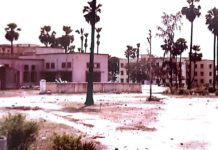HISTORY
Deadly explosives were used in China in 1221, by Jin dynasty army against Song Dynasty’s city. Bombs built using bamboo tubes appear in the 11th century. While bombs made of cast iron shells embraced with explosive gunpowder date to 13th century.
A term was coined for this bomb (Thunder-crash bomb) during Jin dynasty (1115–1234) naval battle of 1231 against the Mongols. The History of Jin (compiled by 1345) states that in 1232, as the Mongol general Subutai (1176–1248) descended on the Jin stronghold of Kaifeng, the defenders had a “Thunder-crash bomb” which consisted of gunpowder put into an iron container and when the fuse was lit, it resulted in a humungous explosion, the noise of which resembled that of thunder, audible for more than a hundred li. (“ li ” also known as the Chinese mile) The vegetation was scorched and was adulterated by the heat over an area of more than half a mou.
The first man made nuclear explosion occurred on July 16, 1945 at 5:50 am on the Trinity Test Site near Alamogordo, New Mexico in the United States, an area now known as the White Sands Missile Range.
A uranium-gun type nuclear bomb (Little Boy) was dropped on the Japanese city of Hiroshima on August 6, 1945, with a blast yield of 15 kilotons; and a plutonium implosion-type bomb (Fat Man) on Nagasaki on August 9, 1945, with a blast yield of 21 kilotons.
In 1963, the United States, Soviet Union and United Kingdom signed the Limited Test Ban Treaty, pledging to refrain from testing nuclear weapons in the atmosphere, underwater, or in outer space. The treaty permitted underground tests. Many other non-nuclear nations acceded to the Treaty following its entry into force. However, three nuclear weapons states – France, China and North Korea refused to pledge.
Chemical explosives fall under two categories – Low and High explosives
Important explosives include Trinitrotoluene (TNT), Dynamite, Nitrocellulose, Nitroglycerin, and Picric acid. Cyclonite (RDX) was an important explosive in World War II. Ammonium nitrate is of major importance in blasting.
FACTS
1.The US Air Force researched a “Gay Bomb” – a non-lethal bomb containing really strong pheromones that would make the enemy forces attracted to each other. It won the 2007 IG Nobel Prize.
2. USA developed an experimental during World War 2 called Bat bombs. They were large bomb casings that would open above cities and release bats with small, timed incendiary bombs. The bats would find somewhere to roost and the incendiaries would start fires in inaccessible places.
3. Lazy Dogs do not explode but are small, unguided kinetic missiles that are only 1.75 inches across. They are dropped over a battlefield and they pack the punch of a 0.50 caliber bullet.
4. On July 1, 1916 at the Battle of the Somme (WW1), a charge of 60,000 lbs was detonated creating a crater that was 300 feet across and 90 feet deep. The explosion, which occurred in France could be heard as far away as London and was the loudest manmade sound in history at that time.
5. US bombers dropped a bomb every eight minutes, every day from 1964 to 1973 on Laos. They dropped more bomb on Laos during this time than the US did in all of WW ll.
What is meant by ‘suicide attacks’?
Suicide bombings are those that involve the deliberate death of the perpetrator. The perpetrator functions as a sophisticated guidance system for the weapon, capable of approaching a target and detonating at the most devastating moment.
The first large suicide bombing campaign after the Second World War occurred in the 1980s, during the Israeli occupation of Lebanon. The largest bombings happened on 23 October 1983, when a truck was driven into a US Marine base in Lebanon, using 2,000 pounds of explosives. The bomber killed himself, along with 241 military personnel. Seconds later, another bomber struck the operations building of French paratroopers and killed 58 more.
RDX
RDX is the organic compound with the formula (O2NNCH2)3. It is a white solid widely used as an explosive. Chemically, it is classified as a nitramide, chemically similar to HMX.
It was discovered by Georg Friedrich Henning of Germany and patented in 1898 but not used until World War II,
The name RDX was coined by the British. This name was accepted in the United States, although the name cyclonite was also commonly used there. The Germans called it hexogen, and the Italians called it T4.
RDX is a hard, white crystalline solid, insoluble in water and only slightly soluble in some other solvents. Sensitive to percussion, its principal non-military use is in blasting caps. It is often mixed with other substances to decrease its sensitivity.
RDX was used by both sides in World War II. The US produced about 15,000 long tons (15,000 t) per month during WWII and Germany about 7,000 long tons (7,100 t) per month. RDX had the major advantages of possessing greater explosive force than TNT used in the World War I, and requiring no additional raw materials for its manufacture.
The assassination of Rajiv Gandhi, near Chennai, in Tamil Nadu, India on Tuesday, 21 May 1991 At 22:21 an assassin, Dhanu, approached and greeted him. She then bent down to touch his feet and detonated an RDX explosive-laden belt tucked below her dress. Gandhi, his assassin and 14 others were killed in the explosion that followed. The assassination was caught on film by a local photographer, whose camera and film was found at the site, though the photographer also died in the explosion.
Author: Harshit Anand





